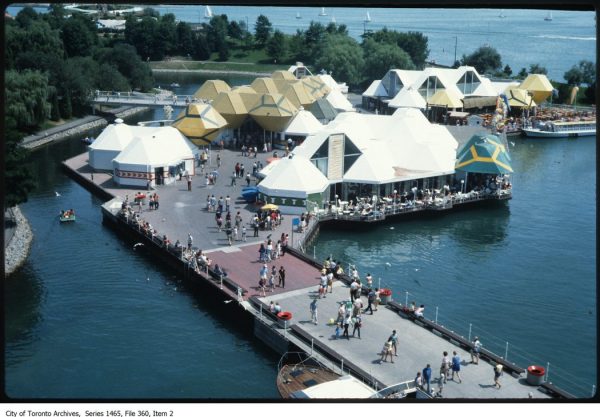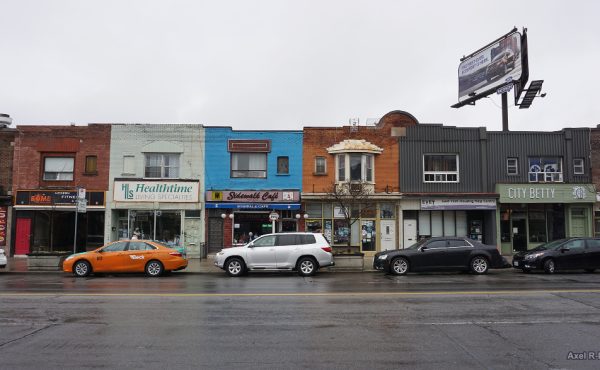Over the past year or so, the debate over the future of Ontario Place — and particularly the West Island — has focused, mainly, on what will happen above ground. With the formal submission of Infrastructure Ontario’s revised planning application last week, we now know pretty much what the province and its client Therme Group envision for both the building and the so-called public spaces around it.
But besides the province’s pledge to build a vast underground parking garage next to Therme’s entrance pavilion, there’s been virtually no public or political attention on what will happen below grade — or, more precisely, below the waterline — to enable the construction of Therme’s $350 million human aquarium. All we’ve been told, at a high level, is that the province will spend $200 million on outlays like erosion control, servicing, landscaping and other non-Therme public space enhancements.
That number, to begin with, seems totally back of the envelope — a figure IO floated at some point in 2022, well before public and professional criticism forced IO’s consultants to expand the public realm around the spa.
No one knows whether that figure bears any relation to reality, but I suspect that the final bill — should the Ford government ever agree to share the budget with the people who paid the tab (us) — will be far in excess of $200 million. What’s more, the required upgrades, especially to water and wastewater infrastructure for Ontario, will require costly improvements to the City’s own pipes and pumps, and it’s by no means clear who will be footing those bills.
Some early glimpses of the sheer extent of what will need to be done below grade at Ontario Place can be found in a highly technical engineering document, the “Functional Servicing Study,” prepared by IO consultants Fotenn and T.Y. Lin about a year ago and available on the city’s planning application site.
The consultants determined that the existing water, storm sewer and sewage infrastructure was, unsurprisingly, wholly inadequate for the all the additional site uses, and will have to be replaced with more and larger pipes, additional on-site pumps, private storm water run-off systems, new drains, and increased pressure in the fire hydrant lines.
The operational impact of all that new infrastructure will, uh, spill over into the city’s water and waste water infrastructure, and could even affect Therme’s plans. For example, the report points out that the “proposed system would include a central [sewage pumping station] that would receive sewage from the majority of the stations within the Central and East Islands. This facility would ultimately pump to the City’s combined sewer along Lake Shore Boulevard.” (There’s a similar caution about storm water run-off from the large new structures proposed for the site.)
If you’ve been following the bouncing ball, you’ll recall that one of the weirder sub-plots in the Therme melodrama is that the company wants to abandon a pristine piece of waterfront (Pebble Beach) and instead build a beach fantasia on the west side of the island — a spot that is notably contaminated by a combined sewer outflow just off this very spot. In other words, it seems possible that under certain conditions (e.g., heavy rains), one part of the renewed and more intensively used Ontario Place may end up polluting another part.
Here’s another complicating detail. According to the report, Therme wants to drain its pools and whirlpool baths from time to time. The problem, as the consultants note, is that the City’s 2021 sewage bylaw actually prohibits this kind of dumping of chlorinated water. Similarly, according to other city rules, Therme won’t be able to pump groundwater from its foundation into local sewers, which means the company will have to build a completely waterproof foundation as well as a separate system to collect and shunt away water that pools inside this massive building’s basement area (which, like that 2,100-space parking garage, will be built below the water table).
Finally, T.Y. Lin’s tests showed that there’s not enough water pressure in the general area of Ontario Place and the CNE to operate fire hydrants at the scale required for such large structures, which is not a minor detail. Solving this problem means adding capacity and water pressure outside the Ontario Place lands, i.e., within the City’s own infrastructure. The consultants mention, for example, upgrading a water main on Dufferin. “Opportunities to mitigate the deficiency outside of the Ontario Place lands may be required along with the necessary capital improvements, in consultation with the City.”
The question, of course, is who will pay for the additional off-site infrastructure: Should City of Toronto taxpayers foot this bill, or will the Ford government continue to dig ever deeper into the provincial treasury to bring this mega-project to fruition? We definitely haven’t had that debate yet. (City officials say the forthcoming report from the planning department on the revised application will contain more detailed analysis of the onsite infrastructure upgrades.)
I am certainly not qualified to assess how far the $200 million earmarked for site remediation and other upgrades will go. But if one takes an even cursory glimpse at the cost of larger Toronto Water capital projects, it’s not difficult to conclude that this amount will be nowhere near sufficient.
Which, of course, is no surprise. After all, Ford wants to transform Ontario Place into a year-round entertainment complex. If you add up all the new traffic generating amenities — the spa, an enlarged concert venue, a new restaurant/pub zone, a larger marina, the Science Centre, the parking garage, etc. — well, a lot of water’s going to be flowing in to Ontario Place and a lot of crud is going to be flowing out — both to the Ashbridges Bay sewage treatment plant but also to the lake itself.
Point is this: Queen’s Park has done its utmost to hide the financials of its dirty deal with Therme, and there’s every reason to expect that Ford & Co. will seek to conceal the infrastructure and site rehab outlays. Such secrecy, as has been said often but bears repeating, stinks: we should all be demanding to know just how much money an ostensibly conservative government is prepared to shovel into this 63-hectare property.
Will it be $650 million? A billion? More than a billion, if we add in a century’s worth of bargain basement rents for Therme? How much will it cost Ontarians to sate Ford’s ego, and what else could we be doing with all those dollars?
Ontario Place, it appears, has become a fiscal sinkhole with no bottom.






4 comments
Doug Ford is a serial liar implicated as drug seller in politician Dad’s territory Etobioke in 1980s by both Editors of Globe& Mail and Toronto Star by an investigation in 2011.
He’s a bully that claims to be for little guy but his actions such as telling homeless to get out of the city !
As a senior& former supporter of PC Ontario I’ve talked to people in party that confirm what I’m saying.
This water front is the only beautiful thing Toronto got going for them . Doug Frod got to go he’s wrecking Ontario every where ,Ontario place,Greenbelt, Health care,why is he still here ?
Wow. I haven’t been able to find the “functional servicing study”. Maybe you can share a link or do a more indepth dive of what official documentation is available.
Thanks for this, and yet another bad deal for the taxpayer, or some of them?! So, if it’s not so much in the public interest, then who’s benefitting? Construction interests? Some property owners? (I don’t think the Adam Vaughan piece on the Ex changes in West End Phoenix of last summer is online but “Downtown Relief this ain’t:). And this ‘cui bono’ can and should also be asked with the major transit construction projects, including the Ontario Line, at a billion a kilometre, though we need transit investment, not merely big spendings.